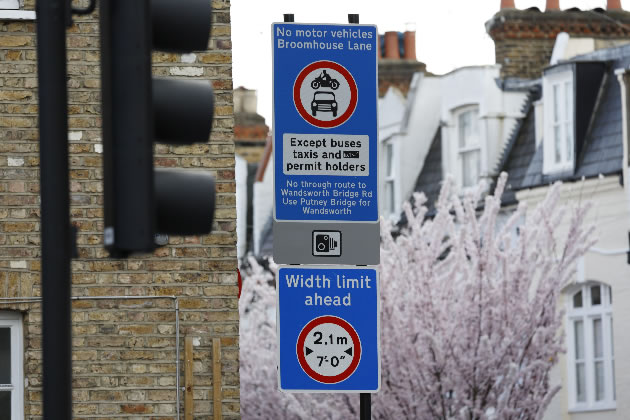Clean Air Zone 'Success' Leads to Fall in Parking Revenue
Opposition says fall in fines reflects damage to the local economy

The trial west of Wandsworth Bridge was implemented in February 2023. Picture: Facundo
September 9, 2024
Hammersmith & Fulham Council is forecast to receive millions less than expected in parking for 2024/25 largely because of the ‘better than expected’ results of its clean air schemes.
The borough is projecting a shortfall of £6.7 million for the year ahead in its parking service area. While the local authority has said there are multiple factors involved, a spokesperson told the Local Democracy Reporting Service (LDRS) the drop in Penalty Charge Notices from its Clean Air Neighbourhoods (CANs) is the biggest and most significant element.
In March this year, the council made permanent a trial scheme launched just over a year prior covering an area west of Wandsworth Bridge Road. This joined a separate CAN implemented to the road’s east, which had been in-place since December 2021.
Unlike typical Low Traffic Neighbourhoods (LTNs), the CANs deploy cameras to fine out-of-borough drivers cutting through local streets in a bid to reduce vehicle numbers and improve local air quality. Certain groups, such as Black Cabs as well as residents, are exempt.
Data published by Hammersmith and Fulham ahead of the trial’s permanent adoption found it had removed an average of 7,000 vehicles from its roads every day, alongside cuts to carbon dioxide (CO2) and nitrogen oxide (NOx).
Critics however accused the local authority of using ‘selective data and partial facts’ in its report, adding it has ignored ‘thousands’ of residents with concerns.
Those without exemptions caught driving through one of the access points of the CANs are fined £65 if paid within 14 days, or £130 if not. Data released earlier this year revealed that for 2023, the two schemes pulled in £11.8m – £7.8m from the western zone, and £4m from the eastern.
In a report published ahead of next Monday’s (9 September) Cabinet meeting, outlining a review of the council’s revenue budget for 2024/25, the local authority records a ‘forecast variance’, or shortfall, of £6.7m for its parking service area.
In a commentary box next to the figure, council officers wrote, “The council has waived fines and introduced business visitor permits and visitors to support the local economy. There has also been a better than anticipated change in driver behaviours leading to a reduction in traffic volumes and forecast income.”
Hammersmith and Fulham has separately told the LDRS that while the drop in Penalty Charge Notices from the CANs is the biggest factor in the shortfall, other inputs include the reduction in Pay and Display charges and decreases in both car ownership and overall traffic volumes.
They added the number of contraventions by out-of-borough motorists cutting through side streets has dropped by about 80 per cent since the trial to the west of Wandsworth Bridge Road was launched last February, and that the council expects fines in 2024 to be about a third of those recorded in 2023.
Conservative councillor Afonso Jose, who sits on Hammersmith and Fulham’s Climate Change and Ecology Policy and Accountability Committee, said the fact people are ‘actively avoiding’ the South Fulham area ‘is not something to be celebrated’.
“This used to be a destination, where those from neighbouring areas came to shop at our local businesses, and freely visit family and friends,” he said. “The council has used this scheme as an easy way to balance the books, but the long-term damage to our local economy and the division caused to the community is the real tragedy.”
A Hammersmith and Fulham spokesperson pointed to data for 2023 which found that, compared to 2022, sessions on the RingGo app were up 9.36 per cent in parking zones in the south of the borough. The report also found sessions had increased by 7.36 per in the four zones closest to the CANs, with businesses providing on average access to more than 4,500 customers through the cameras each month.
The spokesperson added,“We are really pleased that out-of-borough motorists have stopped using residential streets as commuter cut-throughs in South Fulham.
“There are now 15,000 fewer cars every day using those streets while 1.4 tonnes of deadly NOx and two tonnes of climate-damaging carbon emissions have been removed from the air.
“Pollution from congestion has become a thing of the past. Residential streets are now quieter, cleaner and safer. Compliance by drivers is regularly over 98 per cent. This demonstrates that the Clean Air Neighbourhoods have been a success.
“We are now cracking on with our plans to transform Wandsworth Bridge Road into a clean and green place that puts people first, a destination high street at the heart of the community.”
Other service areas where the council is forecasting a variance include temporary accommodation, with a projected overspend of £7.6m. The council’s report notes this is primarily due to an additional 162 people in bed and breakfast at more costly rates, and a growing use of commercial hotels.
Ben Lynch - Local Democracy Reporter